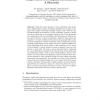Free Online Productivity Tools
i2Speak
i2Symbol
i2OCR
iTex2Img
iWeb2Print
iWeb2Shot
i2Type
iPdf2Split
iPdf2Merge
i2Bopomofo
i2Arabic
i2Style
i2Image
i2PDF
iLatex2Rtf
Sci2ools
ALGOSENSORS
2008
Springer
2008
Springer
Simple Robots in Polygonal Environments: A Hierarchy
With the current progress in robot technology and related areas, sophisticated moving and sensing capabilities are at hand to design robots capable of solving seemingly complex tasks. With the aim of understanding the limitations of such capabilities, swarms of simple and cheap robots play an increasingly important role. Their advantages are, among others, the cost, reusability, and fault-tolerance. While it can be expected that for a variety of problems a wealth of robot models are proposed, it is rather unfortunate that almost all proposals fail to point out their assumptions explicitly and clearly. This is problematic because seemingly small changes in the models can lead to significant differences in the capabilities of the robots. Hence, a clean assessment of the "power of robot models" is dearly needed, not only in absolute terms, but also relative to each other. We make a step in this direction by explaining for a set of elementary sensing devices which of these device...
| Added | 12 Oct 2010 |
| Updated | 12 Oct 2010 |
| Type | Conference |
| Year | 2008 |
| Where | ALGOSENSORS |
| Authors | Jan Brunner, Matús Mihalák, Subhash Suri, Elias Vicari, Peter Widmayer |
Comments (0)

